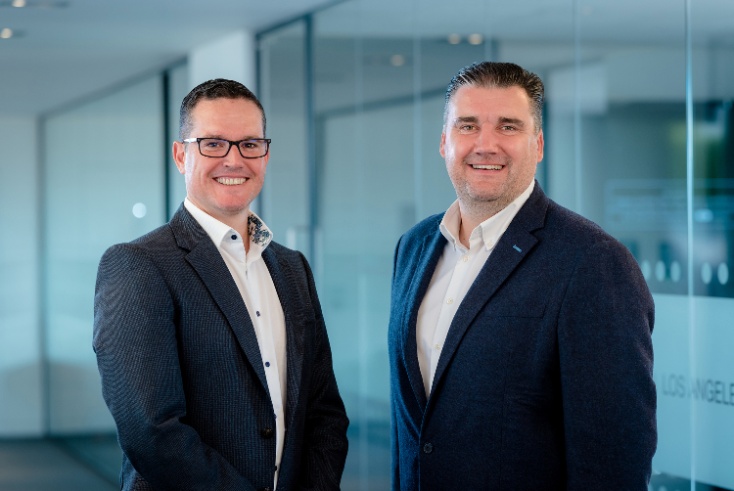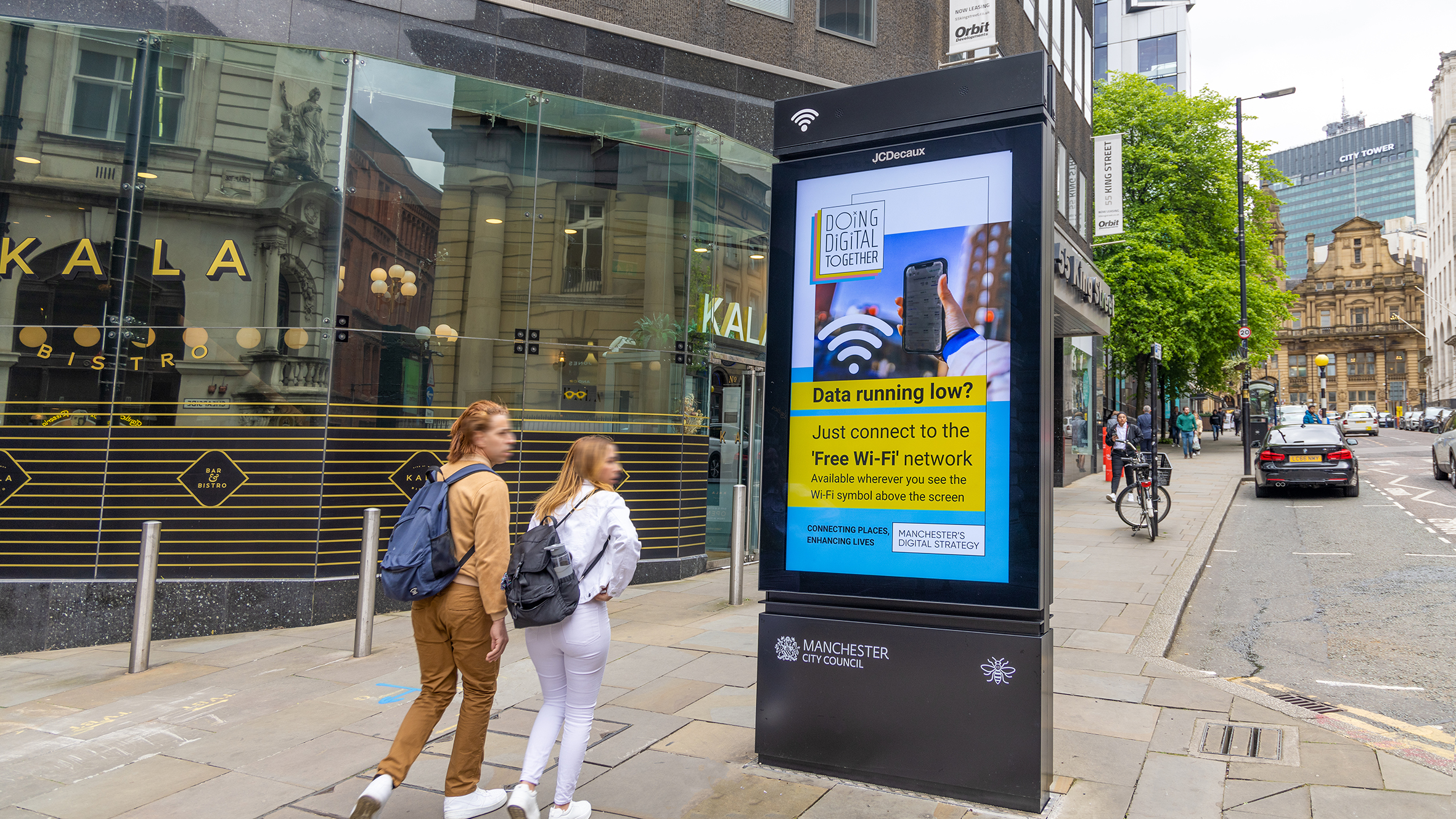JCDecaux UK co-CEOs: OOH sector needs brave marketers

The Media Leader interview
Chris Collins and Dallas Wiles tell Ella Sagar about their plan for outdoor to attract 10% of UK advertising spend — more than double what it is today — and stop harking back to the pre-pandemic times.
“I’m not going to talk about the terrible p word,” JCDecaux UK’s co-CEO Dallas Wiles warns during this interview with The Media Leader, but it turns out to be an impossible task.
It’s been four years since Dallas Wiles and Chris Collins were appointed as co-CEOs of JCDecaux UK and for more than half that time, the outdoor industry was brutally affected by the Covid-19 pandemics. Not only did lockdowns force workers and consumers to stay home for months at a time, but patterns have still not fully settled now as hybrid working evolves.
So during a period of crisis and transformation for the world’s biggest out-of-home company, are two heads better than one? Co-CEOs are somewhat of a family tradition at the outdoor company, now led by brothers Jean-Charles Decaux and Jean-Francois Decaux. But how does it work in practice?
Speaking to The Media Leader at JCDecaux’s London office, Wiles says co-leadership and joint responsibility has been going for a long time, with successful duo examples across music, film, TV and business.
Both of them came into the outdoor business, with Wiles coming up through the commercial side of the business, and Collins starting his career in corporate finance before working at Maiden Outdoor which was acquired by Titan Outdoor, which in turn was taken over by JCDecaux.
Their distinct work experiences help their co-leadership and Wiles and Collins say having two people’s views and visions can make the speed of change and decision-making go quicker as you have someone to bounce ideas off each day and, contrary to some opinions, it does not lead to delayed sign-off.
As Collins explains: “Trust is key, but also learning from the other. There are areas of our business that both Dallas and I are very much going to be involved in, so if you look at say People might sit under Dallas as a direct report, and Operations & Finance is set up under me as a direct report, but they affect the whole business so you do have to very much learn from each other and work in the spirit of collaboration, because you can’t run a business, any part of a business, without the People team for example.”
Another key to their co-leadership arrangement is the ability to challenge and question each other in “the right way”, adds Collins, who also highlights that the longest part of decision-making is self-doubt which is removed when working collaboratively with someone.
They are in each other’s offices, which are across the hall from each other, multiple times a day, and if not, they are on Teams calls or on the phone, although they prefer in-person
This in turn helps remove one potential problem some find with being promoted to C-suite; isolation and loneliness. This was especially the case during lockdown when Collins and Wiles chose to come into the office and it was “a ghost town”.
Wiles and Collins have tried to change the culture at JCDecaux so this collaboration trickles down not just to the board directors but also the rest of the company.
Collins explains: “We feel the business is transforming in terms of moving away from a more siloed business that was very focused on presenteeism at times, and actually really try to help not just attract talent, but retain talent and make sure that the talent is the right talent which offers different creative thinking within the business. We really want to make sure we can evolve in that manner.”
They want to change the way the business works to make it people-first and a fun place to work with some examples of initiatives like weekly boxercise classes in the office (going on next door during our interview), running clubs, cycle schemes, bake-offs, and more, plus mental health measures for the benefit of employees like counselling, private healthcare for UK employees, monthly mental health talks and training 20 people to be Mental Health First Aiders on top of the current 40 already trained.
Collins stresses this is a long-term plan which is important as a family business to offer family services, while Wiles wants to ensure it is authentic and not a tick-box exercise. For example, both them and the board are bonussed based on diversity in senior management and sustainability metrics like reducing cost of petrol and reducing electricity.
On the subject of talent, Wiles says that one of the main opportunities and challenges for the business is getting in digital talent to help it grow the industry.
Currently OOH is known more as a traditional broadcast channel, but on average across the industry 65% of revenue comes from digital screens, with JCDecaux slightly ahead of this average with a high proportion of rail and airport inventory.
Wiles explains that as long as 80p in every pound is traded programmatically and digitally, and out of home is not part of that ecosystem, then outdoor media owners “don’t really get a look in”.
Wiles adds: “The world has changed and what we realised is that there are a lot of new talent in businesses that haven’t had the education and the understanding of our channel that maybe they had pre-pandemic, and dare I say a lot of companies have got less people working for them than they did pre so the number of people going out into the marketplace is slightly different, and also a lot of people are working from home on Teams calls and Zoom calls- I think agencies are flat out.”
Gone are the days of going to an agency and being presented with 20-page paper brief to take away for a week to work on, he adds.
Brave CMOs and clients can take OOH to a 10% medium
Wiles says that, at some point, we need to “stop talking about 2019”, and carry on with a positive mindset for growth. He remembers when he joined JCDecaux early in 1999/2000 and then out of home wanted to be a 10% medium, and it’s now at around 4.5%.
“We want to be 10%, and I think we should be 10% but we’ve got a job at hand, and we’re not going to give up.”
Wiles says there needs to be “a rebalance” with tech companies to reach that goal. Also he stresses that out of home can amplify other channels and is not that difficult to buy, especially with programmatic.
In order to get there, Wiles and Collins highlight that advertising needs to “flip” to be 20% focussed on transaction, and 80% on advertising rather than the other way around, and that both CMOs and clients need to be braver.
Wiles says: “I think CMOS needs to be a bit braver — you don’t get fired for booking Facebook or Google or social. It’s quite easy to point at. A couple of years ago, the average CMO was enrolled for two and a half, three years — so are you going to disrupt? Or do you do branding and the Binet & Field 60-40? The best of both worlds?”
“We know out of home works particularly well so hopefully there’s going to be those braver CMOS of the future who realise that public advertising is great, it’s here to stay, we’re not going anywhere, and as a business will continue to invest in the future.”
Brave clients are also needed to “join in on the challenges”, as it only takes a couple of brave clients to do something “to point at” to give the others FOMO (fear of missing out).
Collins feels there are a lot more creative campaigns now than last year or two years ago.
“The boldness of advertising is coming back and people have come out of the negativity and are starting to be a lot more bold with their choices and realise that actually, the brand fame out of home and certain creative campaigns can deliver is unbelievable,” he remarks.
Collins and Wiles are confident out of home can grow significantly, deliver diverse audiences reaching 95 – 96% of the UK population, up their sustainability credentials, and give back to local areas.
Wiles adds: “Although we are in the public domain, we are one of the smallest sectors in advertising — that’s our bugbear. We do all these great things, we are authentic, we reach multiple diverse, inclusive audiences but I think we have to fight harder than most channels, although we’ve got a brilliant story and we’re the oldest channel.”
Another part of the puzzle towards growth is collaborating with other out of home media owners, which both Collins and Wiles admit they have not been as vocal about as an industry.
They both say everyone in the industry has been investing more into messaging so it is consistent so they “sing from the same hymn sheet”.
They are working with other major outdoor media owners on Playout (a new system to unify tracking and verification of all out of home advertising in the UK), and have input into the joint industry currency Route and marketing body Outsmart which has hired a marketing lead to convey a consistent message about the industry to wider adland.
Collins highlights: “You’re advertising in a brand safe environment, one that has very good ESG credentials, and also gives back to the local communities. That’s a pretty compelling story when you look at those three things, so I think that is a great opportunity and we’ve got to keep going out and telling that story.”
Both also make the point around out of home being an accountable medium as it has invested so much in data to prove its benefits and change the market share.
What’s next for outdoor advertising?
Collins sees audience numbers are back to 2019 levels but that there has been a shift in travel patterns. For instance, footfall on weekends on rail are higher than 2019 but on other days they are 20 to 30% down.
However, Waterloo station still sees two million people travelling through it per week.
Another outdoor trend is more “bleisure” travellers through airports where people can combine their business and leisure travel by tacking on a few days of remote working on to a business trip.
And in an addition to their “lifesaving street furniture” like their defibrillator products which have been used more than 500 times, JCDecaux UK recently introduced wifi access in 22 locations in Manchester through its Community Information Panels (CIP digital screens) fitted with Smart City technology in partnership with Manchester City Council (pictured, below).

Wiles says of the changes outdoor has gone through: “We’ve been in role for just over four years — I’m not going to talk about the terrible p word and all that but actually that’s forced us to change and the advertising sector is more digital now. The ecosystem has changed completely, or let’s say is accelerated far quicker than maybe it would have done without Covid getting in the place. So, for us, it’s about making those changes quickly and as nimble as possible because sometimes you only make change when someone says: “don’t you think is about time you change something,” otherwise you could rest on your laurels.”
* Editor’s note: This article originally stated 65% of out-of-home screens are digital, when in fact 65% of OOH revenue is from digital screens. We understand about 6% of OOH sites in the UK are digital.



